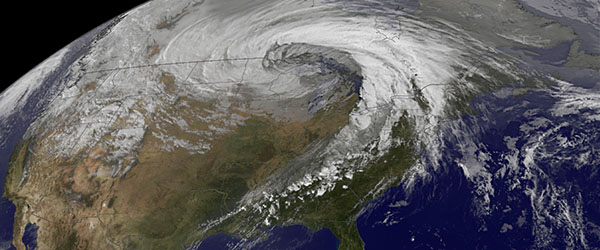

Extratropical cyclones are large swirling storm systems that form along the jet stream between about 30 degrees and 70 degrees latitude. Cyclones are the parent storms from which much of the severe weather of the middle latitudes develops. In the cold season, extratropical cyclones produce hazardous winter weather ranging from heavy snowstorms to blizzards and ice storms. In their wake, the cold air flowing across the Great Lakes often induces heavy snowfall on their leeward shores. The focus of research in the Department has been on mesoscale and microscale processes within winter storms that lead to hazardous weather events. The Department is also conducting research on measurement of precipitation in winter storms, particularly from satellite-based radar platforms and from ground-based radar systems.
Students in our department have flown in research aircraft into the heart of winter cyclones. They have used Doppler radars and other instrumentation to investigate the structure of winter weather systems such as Lake Effect storms to deduce their internal dynamics, thermodynamics and microphysical processes. Our students carry out advanced numerical simulations of winter cyclones, and particularly the mesoscale features within them, such as bands, convection, and cloud top generating cells. They test hypotheses about the structure of these weather systems derived from their understanding of the observations they helped to collect. Our faculty and students work with advanced aircraft and remote sensing instrumentation systems as well as state-of-the-art modeling systems to conduct their research. Our students have been in many field campaigns—and not just watching! They have designed research missions and even sat in the cockpit of research aircraft directing scientific investigations.
Faculty working in Extratropical Cyclones and Winter Storms







Related News
- The Department of Atmospheric Sciences has a new name: The Department of Climate, Meteorology, & Atmospheric Sciences (CliMAS). The name change was approved by the University of Illinois Board of...
- Balloon launches are typically the stuff of birthday parties and photo opps unless you’re an atmospheric scientist trying to gather storm data in tandem with NASA research planes navigating their way...
- As students in atmospheric sciences, Troy Zaremba and Kaylee Heimes both refer to their time conducting undergraduate research at...

